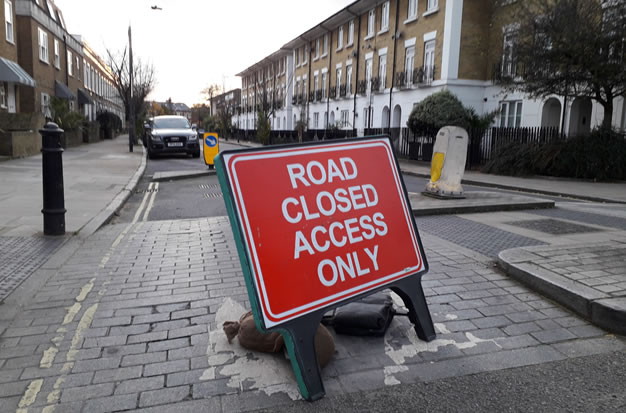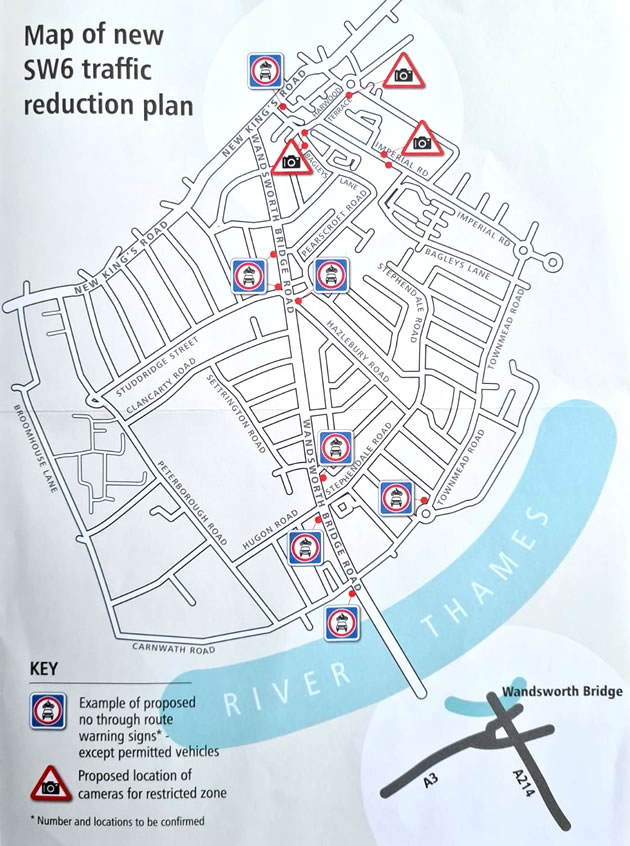Mixed Reaction to 'Pioneering' Sands End Traffic Proposals
Some residents of Harwood Terrace angry at outcome of closure experiment

Harwood Terrace road closure. Picture: Owen Sheppard
A “pioneering” traffic scheme to stop non-residents entering parts of Fulham could be up and running by mid-July, but residents are unsure of whether it will succeed.
Hammersmith and Fulham Council is devising a traffic system for Sands End, where (ANPR) automatic-number-plate-recognition cameras will be installed at junctions that lead to the area.
Under the scheme, vehicles including motorbikes that are not permitted to pass “entry points” to the area will be fined. This will not affect residents of the borough.
It comes after months of arguments between residents of neighbouring streets, which began with the council’s highly controversial decision to close an overused rat run, Harwood Terrace, for a six-month trial.
To quell the debate over how to fix Sands End’s traffic woes, the council created a Working Party of up to 20 residents from streets around Bagleys Lane that were affected by the trial closure.
The new ANPR scheme has been presented by the council as a compromise, and the agreed product of those Working Party meetings, of which several have been held since January.
A council spokesperson said: “Working with residents, we have developed a pioneering traffic reduction scheme which uses the latest smart camera technology to halt rat-running by out-of-borough drivers.
“The scheme is planned to go live in mid-July and will significantly reduce traffic across the whole SW6 area.”

The last meeting on June 3 was chaired by senior councillor Ben Coleman. Up for discussion was whether private-hire vehicles, such as Ubers, should be included in a “whitelist” of vehicles that will be allowed to pass the ANPR cameras. Others that will feature on the whitelist include delivery drivers, buses, emergency services, and local residents’ guests – but they will have to register online in advance.
Sources who attended Wednesday’s Working Party meeting have mixed feelings about how the new scheme will work.
Casey Abaraonye of HF Cyclists, and who lives in King’s Road, said Harwood Terrace should remain closed as part of the scheme.
But on other aspects he said: “I think it’s a novel idea. It’s not using a sledgehammer to crack a nut, but maybe a clawhammer.
“It’s going to reduce through traffic [in Sands End] but not stop it. It’s not a terrible scheme because it provides some ownership for local residents. But if you broaden the categories of vehicles who can go through, it becomes less effective.”
Another attendee, James Spokoini, was one of those most vehemently against the closure of Harwood Terrace in October 2019, and was highly critical of how the council carried out the trial.
After Wednesday’s meeting, Mr Spokoini said the scheme’s success “will depend on how they refine the details.”
“How much of a difference it will make will depend on the council’s assertion that 90 per cent of all the traffic [entering Sands End via Wandsworth Bridge Road] was from outside the borough. I’m slightly dubious about that.”
Mr Spokoini added: “I hope if things go wrong they [the council] will be responsive and honest with residents. It’s going to be complicated, there’s going to be teething problems.”
Some in Harwood Terrace say they have been left out of the Working Party process, and they are angry that it will reopen under the scheme.
Lucy Knight, a solicitor, was a member of the Working Party, but claims she was “ghosted” and “booted out” of the group in late February, after writing a highly critical email to Mr Coleman that went unanswered.
In her email, she said the council’s desire to press ahead with the scheme, and reopen Harwood Terrace, ignored the council’s own traffic data, from before the lockdown, which showed that some streets were seeing less traffic.
Survey data presented to the Working Party by the council showed that congestion in Bagleys Lane increased by 25 per cent due to Harwood Terrace closing. While New King’s Road, King’s Road and Imperial Road saw a combined average reduction of 21 per cent.
Ms Knight said: “They were saying it was very important to find a compromise, whereas I was saying if you look at the evidence [closing Harwood Terrace] has been positive and accidents have come down.
“It felt like they’ve had this idea right from the start… It seems like the council have got themselves into a lot of trouble and they just wanted to get the traffic flowing again.”
A council spokesperson said, “We are sympathetic to the traffic problems faced by Harwood Terrace residents over the years. That’s why we agreed to a time-limited experiment. It was always clear that it was an experiment, not a permanent closure…
“We are now acting on the experiment’s findings. The key ones are that, while it ended rat running in the terrace, it displaced large amounts of traffic to surrounding streets and caused long traffic delays, including to buses. We also learnt that 90 per cent of the traffic was being caused by non-H&F residents.”
Ms Knight added: “Ever since I sent that letter they basically ghosted me. I’ve been booted off. It’s really shocking. They didn’t respond to my email or give me any warning. There was no explanation.”
Several Harwood Terrace residents have shared emails to the council, expressing disappointment that their street will reopen, and alleging that they have not been listened to.
Owen Sheppard - Local Democracy Reporter
June 10, 2020